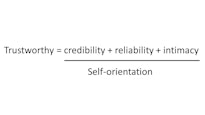Trust in the Workplace
A Harvard Business Review report found that those who work in high-trust environments experience 74% less stress and have 106% more energy at work.
Trust in the workplace creates a place where everyone feels comfortable and supported. In turn, this improves productivity and job satisfaction.
But what does trust in the workplace look like?
Trust consists of three elements:
- Consistency
- Good judgment
- Positive relationships
Senior staff members and employers control these elements, yet so many don't realize the hostile work environments they are creating.
Likewise, when managers or employees are informed that something is wrong with the work culture, they often become defensive, ignoring the situation or blaming employees.
Instead of regularly offering praise or constructive feedback, an environment with little trust leaves you wondering:
- How is your boss going to react to your work?
- Will you be yelled at or ridiculed in public?
- How is your performance overall?
- When is your next review or promotion?
If you work in a place with trust, you feel comfortable:
- Talking to your colleagues and senior management
- Offering alternative solutions
- Addressing mistakes made by your manager
- Approaching your manager when you need an extension or have made a mistake
- Openly discussing any issues you may be having personally and even professionally
No-trust environments create fear and uncertainty. They are the reason why 81% of employees want to resign from their jobs.
Sadly, 91% of employees feel their leaders lack the necessary communication skills to create trust. Yet, so much depends on this.
As an employee, you can't fully control the work environment. Still, there are things you can do to help influence or steer people in the right direction.
Two Types of Trust in the Workplace
There are two types of trust that you might experience in the workplace. The first type of trust is practical and the second type is emotional.
Practical
For employees, you earn this type of trust by:
- Showing up on time
- Meeting your deadlines
- Doing the work you're supposed to do
- Being a team player
But what most people forget is that trust is two-way. Yes, your employer needs to trust you, but you also need to trust your employer.
This involves them:
- Meeting basic needs such as paying employees on time, and honoring vacation allowances and sick days
- Being open and honest
- Providing feedback
- Being supportive
- Building successful teams
A good example of practical trust in the workplace is:
You and your team work well together, support each other and work towards the same goals.
This ensures that deadlines are met and the work is completed to a high standard. Trust like this allows employees to feel encouraged and secure in their work.
A bad example is:
A team member or manager is always late and doesn't do their part of the work. This leads to missed deadlines, a drop in quality and hostility between team members.
Emotional
This level of trust is not as common, but when reached, can propel an organization to a new level of productivity and success. Those companies are 21% more profitable.
Emotional trust is achieved when a team or organization truly bonds.
There is open communication, everyone feels equal and senior members are understanding.
Emotional intelligence plays an enormous role in this type of trust.
The relationships in these environments are not just professional:
- There is a sense of camaraderie and unity
- Colleagues feel comfortable talking about personal issues
- There is a feeling that everyone has each other's backs – even senior management
Those who work in this type of environment enjoy going to work and feel rewarded.
A negative of achieving this level of trust is when someone decides to abuse it.
With everyone being so open and understanding, a lot of personal information is shared.
Should someone choose to get ahead and not be a team player, they could use that information to make someone look bad or ruin their promotion.

Six of the Best Steps to Build Trust in the Workplace
Step 1. Ask for Feedback
As a manager, asking for feedback from your team opens up communication, which creates trust. It shows your team that you are willing to learn and grow and that you want to create a more collaborative working environment.
Part of the manager's role is to provide feedback, but they very rarely receive any themselves. Let your team or employees know that you welcome their input.
Offer anonymous methods such as questionnaires to start the process.
For employees, during your feedback or review sessions, ask your manager if they would be open to suggestions.
It might be a delicate subject, but any manager not willing to accept feedback should not be in a leadership role.
The company you work for should be investing in high-quality leaders. If they are not, you need to consider the type of people you work for and whether finding a new job would be better.
Step 2. Be Accountable
If you say you are going to do something, do it.
If you make a mistake, own up to it.
Being accountable for yourself and your actions shows that you are a reliable and honest person. The hope is that your colleagues will follow suit and start behaving in the same way.
Your accountability should also impress your manager.
As your manager learns that they can trust and depend on you, they will show you the same. Over time, your relationship will become more open and trusting.
Managers should also hold themselves accountable for their decisions.
It is easy to blame employees for mistakes, but that creates hostility and there is no support in hostile teams.
Step 3. Be Honest and Supportive
It is not only for leaders to be honest and supportive. These elements need to run through the whole team.
There are often occasions when a team member wants to say something but is too scared to. Be that person who says when something is a terrible idea or stands up for a colleague.
Use your teamwork skills to influence a positive change. It sometimes only takes one person to do something right for others to follow.
A manager's role is to be honest and supportive. They should be sharing all the information they have and providing support where and to who it is needed.
If you think your manager is leaving out details, ask follow-up questions.
Step 4. Give Praise and Constructive Feedback
Again, this is not just for managers.
If you believe your colleague has done something well, tell them. If you think they could do something better, mention it.
You don't have to sit them down and give structured feedback. Simple phrases like this are enough:
- "You did [xyz] so well"
- "I love how you do [abc]"
- "That report was so well written"
- "If you are open to it, I've found that doing [mnl] this way is quicker"
Some managers are very quick to criticize and slow to compliment. Start creating a place where you and your colleagues praise and provide feedback between yourselves. Your manager should hopefully begin to do the same.
If not, then that opens up an opportunity to talk about their leadership skills.
Step 5. Invest in Employee Development
The company you work for should be dedicated to your development.
Research shows that employees are 29% more satisfied with their lives when they have a clear career development plan and work in a high-trust environment.
Your company should be investing in you.
As an employee, this allows you to feel supported, appreciated, satisfied and secure.
For an employer, investing in your employees increases productivity, reduces turnover and recruitment costs, and increases profit.
From a PR perspective, having a reputation as a company that values its employees encourages potential customers/clients to buy your services or products.
Step 6. Lead by Example
Be that person that everyone wants to work with.
- If you notice someone is down, talk to them; let them know you are there if they need it.
- If someone is being mistreated, stand up for them.
- If a colleague needs a guiding hand, offer them one.
These are all delicate situations as you don't want to appear to be overstepping your role or intentionally making your manager look bad. But if you don't lead by example, then no one else will, and change will never happen.
Work trends are now more focused on work-life balance, which is making positive changes like this easier.
Leaders are more open to suggestions on improving the work environment.
While the initial steps may seem daunting, the overall result could be a workplace where everyone thrives.

'Credibility' is the words you speak.
Is what you say genuine and does it come from a place of honesty and knowledge?
As a manager, you need always to tell the truth and encourage others to do the same.
Though, in some cases, this may damage your 'reliability', being referred to as a liar will damage both your credibility and reliability.
You should also admit when you don't know something or if you are wrong.
All these small actions prove to your team that you are a credible person who makes human mistakes from time to time. It also allows others to be comfortable with their mistakes.
'Reliability' is our actions. Do you do what you say you will? Are you dependable?
As a leader, you need to show up for your team. Start on time and do the work you are supposed to.
Explaining your thought process shows your transparency and willingness to communicate.
'Intimacy' has to do with the security we feel when we tell someone something.
Show your employees they can trust you by trusting them first. Include them in your decisions and ask them for advice from time to time.
Intimacy also includes your reactions. Be mindful of how you judge people or react to situations. Do you scoff, scowl, laugh?
Your team will never feel comfortable with you if you judge them.
Have an open-door policy so your team knows they can come to you.
'Self-orientation' is our focus. Where do our loyalties lie? Can we be trusted with something because we are a good person, or because that particular thing is of benefit to you?
Practice active listening and give others a chance to talk.
Show your team that you are a team player interested in others' success, not just your own.
The trust equation focuses on people's actions rather than a business or institution. So the equation elements need to come from leaders as human beings, rather than the company telling them to do those things.
Final Thoughts
The trust equation is a useful tool for us to use to govern the way we approach life and the people around us.
So much of our life is spent at work, and our security is dependant on our salary. We need to trust our employees to pay us, and they need to trust us to do our work.
But it goes beyond that simple contract.
To create an environment of trust, you need to:
- Be open and honest
- Be the best version of yourself
- Encourage others to do the same
- Follow the trust equation
If you have the opportunity to speak to senior management about improving trust in the workplace, take it.





